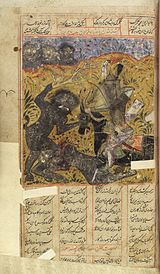Ghoul

"Amine Discovered with the Goule", from the story of Sidi Nouman, of the One Thousand and One Nights
A ghoul (Arabic: الغول, al-ghuûl), is a demon or monster originating in pre-Islamic Arabian religion[1] associated with graveyards and consuming human flesh. In modern fiction, the term has often been used for a certain kind of undead monster.
By extension, the word ghoul is also used in a derogatory sense to refer to a person who delights in the macabre, or whose profession is linked directly to death, such as a gravedigger or graverobber.
Contents
1 Early etymology
2 Folklore
3 See also
4 References
Early etymology
Ghoul is from the Arabic غُول ghūl, from غَالَ ghāla, "to seize".[2] In Arabic, the term is also sometimes used to describe a greedy or gluttonous individual.
The term was first used in English literature in 1786, in William Beckford's Orientalist novel Vathek,[3] which describes the ghūl of Arabic folklore. This definition of the ghoul has persisted until modern times, with ghouls appearing in popular culture.[4]
Folklore

Ghouls gathering for combat in a Persian poem
In the Arabic folklore, the ghūl is said to dwell in cemeteries and other uninhabited places. A male ghoul is referred to as ghūl while the female is called ghulah.[5] A source identified the Arabic ghoul as a female creature who is sometimes called Mother Ghoul (umm ghūla) or a relational term such as Aunt Ghoul.[6] She is portrayed in many tales luring hapless characters, who are usually men, into her home where she can eat them.[6]
Some state that a ghoul is a desert-dwelling, shapeshifting demon that can assume the guise of an animal, especially a hyena. It lures unwary people into the desert wastes or abandoned places to slay and devour them. The creature also preys on young children, drinks blood, steals coins, and eats the dead,[7] then taking the form of the person most recently eaten. One of the narratives identified a ghoul named Ghul-I-Beaban, a particularly monstrous character believed to be inhabiting the wilderness of Afghanistan and Iran.[8]
It was not until Antoine Galland translated One Thousand and One Nights into French that the western idea of ghoul was introduced into European society. Galland depicted the ghoul as a monstrous creature that dwelled in cemeteries, feasting upon corpses.
Ghouls (Persian: غول) also exist in Iranian folklore.
See also
- Aswang
- Ghola
- Ghost
- Jinn
- Qutrub
- Revenant
- Skeleton (undead)
- Undead
- Vampire
- Wechuge
- Wendigo
- Werewolf
- Witch
- Zombie
References
^ "Ghoul | Arabian mythology". Encyclopedia Britannica..mw-parser-output cite.citation{font-style:inherit}.mw-parser-output q{quotes:"""""""'""'"}.mw-parser-output code.cs1-code{color:inherit;background:inherit;border:inherit;padding:inherit}.mw-parser-output .cs1-lock-free a{background:url("//upload.wikimedia.org/wikipedia/commons/thumb/6/65/Lock-green.svg/9px-Lock-green.svg.png")no-repeat;background-position:right .1em center}.mw-parser-output .cs1-lock-limited a,.mw-parser-output .cs1-lock-registration a{background:url("//upload.wikimedia.org/wikipedia/commons/thumb/d/d6/Lock-gray-alt-2.svg/9px-Lock-gray-alt-2.svg.png")no-repeat;background-position:right .1em center}.mw-parser-output .cs1-lock-subscription a{background:url("//upload.wikimedia.org/wikipedia/commons/thumb/a/aa/Lock-red-alt-2.svg/9px-Lock-red-alt-2.svg.png")no-repeat;background-position:right .1em center}.mw-parser-output .cs1-subscription,.mw-parser-output .cs1-registration{color:#555}.mw-parser-output .cs1-subscription span,.mw-parser-output .cs1-registration span{border-bottom:1px dotted;cursor:help}.mw-parser-output .cs1-hidden-error{display:none;font-size:100%}.mw-parser-output .cs1-visible-error{font-size:100%}.mw-parser-output .cs1-subscription,.mw-parser-output .cs1-registration,.mw-parser-output .cs1-format{font-size:95%}.mw-parser-output .cs1-kern-left,.mw-parser-output .cs1-kern-wl-left{padding-left:0.2em}.mw-parser-output .cs1-kern-right,.mw-parser-output .cs1-kern-wl-right{padding-right:0.2em}
^ Robert Lebling (30 July 2010). Legends of the Fire Spirits: Jinn and Genies from Arabia to Zanzibar. I.B.Tauris. pp. 96–. ISBN 978-0-85773-063-3.
^ "Ghoul Facts, information, pictures | Encyclopedia.com articles about Ghoul". Encyclopedia.com. Retrieved 2011-03-23.
^ Al-Rawi, Ahmed K. (11 November 2009). "The Arabic Ghoul and its Western Transformation". Folklore. 120 (3): 291–306. doi:10.1080/00155870903219730.
^ Steiger, Brad (2011). The Werewolf Book: The Encyclopedia of Shape-Shifting Beings. Canton, MI: Visible Ink Press. p. 121. ISBN 9781578593675.
^ ab Reynolds, Dwight (2015). The Cambridge Companion to Modern Arab Culture. Cambridge: Cambridge University Press. p. 260. ISBN 9780521898072.
^ "ghoul". Merriam-Webster Online Dictionary. Retrieved January 22, 2006.
^ Melton, J Gordon (2010). The Vampire Book: The Encyclopedia of the Undead. Canton, MI: Visible Ink Press. p. 291. ISBN 9781578592814.

Comments
Post a Comment